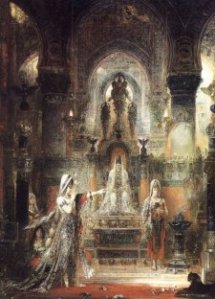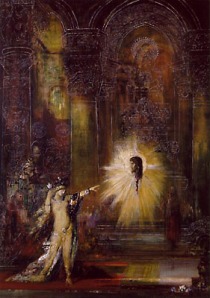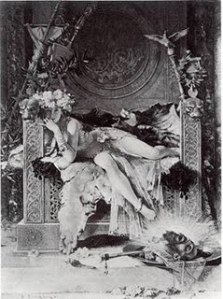Thoughts on Salome in relation to the New Woman
Herod: The moon has a strange look tonight. Has she not a strange look? She is like a mad woman who is seeking everywhere for lovers. She is naked too. She is quite naked. The clouds are seeking to clothe her nakedness, but she will not let them. She shows herself naked in the sky. She reels through the clouds like a drunken woman…I am sure she is looking for lovers. Does she not reel like a drunken woman? She is like a mad woman, is she not? (Wilde 212)
When I first read this passage, I was immediately reminded of Kate Chopin’s Emancipation: A Life Fable and our class discussions about the New Woman. I drew a parallel between the symbol of the animal for the New Woman used in Emancipation and the symbol of the moon as the New Woman in Salomé. Herod describes the moon, a female, as “naked,” (yet not allowing herself to be covered) “seeking everywhere for lovers,” and “[reeling] like a drunken woman.” As we discussed this week in class, the “freed” woman, the woman who has been let out of the cage so to speak, is extremely excited and vulnerable and prone to making mistakes with her newfound freedom. Herod’s passage (above) seems to convey a similar idea. The naked woman is an image of vulnerability, and yet Herod states that “the clouds are seeking to clothe her nakedness, but she will not let them.” This relates to our discussions about the way in which society often looked down upon the New Woman and poked fun at her in order to diminish her power or control. The New Woman, like the moon in Salomé, refuses to be stifled, or in some cases, reuses to be protected from the dangerous and unforgiving society she faces, for to close the equality gap, the woman must be able to find her independent niche in real society. Additionally, I interpreted Herod’s assertion that the moon is “seeking everywhere for lovers” as the way that the New Woman, or the animal in Emancipation, frantically seeks/pursues what she desires without the inhibitions of the status of women at the time. Lastly, I saw the drunken woman or the mad woman as very similar to the freed animal in Emancipation—Kate Chopin describes the animal by saying, “on he rushes, in his mad flight, heedless that he is wounding and tearing his sleek sides – seeing, smelling, touching of all things; even stopping to put his lips to the noxious pool, thinking it may be sweet” (Chopin 307). The image of the drunken woman evokes the sense that she doesn’t quite know what she is doing, that she does not quite know how to act properly, just like the freed animal that is so excited and eager that it makes mistakes and appears foolish.
Personally, I found the New Woman, Herod’s description of the moon, and Chopin’s animal to share a lot in common. They are vulnerable as they navigate through new social territory and experiment with their roles, yet embrace the hardships that accompany the territory because they are eager for social progress.
-SM












